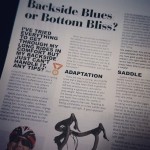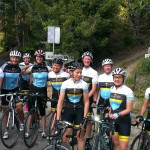Posted by Sara Carrigan – Columnist for Multisport Magazine
I’ve tried everything to get through my long rides in comfort but my backside just can’t handle it, any tips?
Q: “In my 20 years of being involved in cycling, I don’t think I have ever come across a rider who hasn’t suffered some form of pain in the backside. I have certainly experienced my fair share of saddle discomfort along with wincing in the shower after a ride!” — By Cameron
Saddle discomfort can involve a whole range of things for males and/or females including a loss of sensation, numbness, burning pain, bruising, saddle sores, tingling, chaffing, prostate problems, impotency, boils, abscess, ingrown hairs, infections, and raw, inflamed skin. Not the nicest topic to chat about but certainly warrants discussion if we are after a nice ride!
When we cannot ride comfortably in the saddle, not only does it inhibit our performance by compromising pedal efficiency and power production but it makes riding so unenjoyable and in some instances, impossible! It doesn’t matter if we ride for recreation or we ride to race, the bottom line is we want to enjoy our ride!
Here are a few things you can do to allow for a more comfortable ride. Note that I say ‘more comfortable’ and not ‘pain-free forever’!
ADAPTATION
If you are new to cycling, you’ve gotta know that it takes time for your bum to adjust! The area down there is generally soft and sensitive and is not used to supporting a significant amount of your body weight. Allow adequate time for the density and sensitivity of the tissues & bones that contact the saddle to gradually adapt to the load.
Adapting to feeling comfortable on a bike saddle does not happen overnight. A good approach is to be consistent with shorter rides than a few long rides. Even seasoned riders need to allow time for adaptation. At the end of each season of racing, I would enjoy a 4week off-season of no riding and when I started training again, I experienced some pain & bruising as my bum adjusted to the pressure and the load again.
Overweight cyclists are particularly susceptible to saddle issues during adaptation and must progress more slowly when adding time and distance to their riding.
The bottom line: It is not unusual to be uncomfortable at first but as long as you have good quality knicks (without undies!), the right saddle, chamois cream, correct bike fit and good posture … it simply takes time to get used to sitting on a saddle!
SADDLE
Saddle selection is an important factor in saddle comfort. It is certainly not ‘one size fits all’, it is a matter of personal preference and fit to your anatomy whether you have a wide/narrow, soft/hard, hole/holeless, short/long saddle. In fact, a saddle I might love, another rider will absolutely detest and vice versa. The notion that the bigger, softer saddle as being more comfy is not always true!
Finding the right saddle can perhaps be likened to buying a pair of shoes. Just as a shoe needs to fit your foot, the saddle needs to fit your bum; and just as we measure the size of our foot, we can also measure our bum. This measurement is of our sit bones (the ischial tuberosities) and ideally you want these bones supporting your weight on a saddle rather than your soft parts. Additionally, we need to look at the front (nose) of the saddle, which helps to control the bike with your legs and support some body weight. If the nose of the saddle is too wide or too big and bulky, it may be opening your crotch and cause chafing, compress nerves and irritate soft tissue. Even though a saddle may look hard, narrow and ‘mean’, don’t dismiss it, as it may be just the saddle you need!
Thankfully many bike shops now have test saddles to help with finding the right saddle and avoid becoming an expensive process. However, once again, give your new saddle time to adjust!
The bottom line: Don’t be too quick to dismiss a certain type of saddle and when you do choose one, give yourself time to adapt.
GOOD QUALITY KNICKS WORN CORRECTLY
You can’t go past investing in good quality padded lycra! In general, the more expensive knicks do feature tangible features and benefits that make them more comfortable, and in some instances, these features can actually work better than changing saddles! Good quality knicks usually fit better, have sophisticated seamless, anti-bacterial moisture wicking pads that stretch, mould and fit to help reduce friction and are highly breathable. Until you have worn a high quality pair of knicks, you may never understand the benefits and why they are a mandatory piece of equipment!
When buying a pair of knicks, a few elements to look at are:
- The correct size: The whole point of a good pair of knicks is to eliminate seams and layers that can bunch and chafe. If your knicks have a poor cut or are too large, this creates wrinkles and moisture accumulation, and friction and chafing ensue.
- The chamois (pad): Different shapes and cuts of chamois are more comfortable than others and can provide a ride of bliss or a downright painful one! For example, there was one year that the Australian Team kit had a seam right down the middle of the chamois and this was NOT a joyous occasion! We had them changed quick smart!
- Bibs rather than shorts: Consider the use of bib knicks (bib & brace), which feature a ‘suspender’ that stretches over your shoulders to hold your knicks in place and to keep the chamois in contact with your crotch. This reduces movement of the garment, which lessens likelihood of chafing and increases your comfort. Some riders find bib knicks less convenient when it comes to needing the bathroom because they have to take off their jersey but I reckon it is well worth the minor inconvenience!
- No undies!: I repeat DO NOT wear undies underneath your knicks! Cycling knicks are designed to be worn against the skin for both men and women. The Chamois is anti-bacterial so wearing undies can not only be unhygienic but cause all the problems that have been mentioned above. Never wear any underwear with cycling knicks!
- Hygiene: Cycling knicks aren’t made for casual wear, they are made for riding! So limit the amount of time you spend in them when not riding! Try not to drive to training/events in your knicks and don’t sit around in damp, sweaty knicks after a ride. Also, never re-use a pair of knicks without washing them.
The bottom line: Invest in a good quality pair of knicks! You will come to appreciate why spending a bit of mulla on padded lycra is good value!
RIDING STYLE & POSTURE
Your posture on the bike and the way you ride can contribute to being sore in the saddle. Keep in mind that the full weight of your body is not meant to rest entirely on your saddle. Your bike seat is just one of five contact points, upon which you should be spreading the weight of your body. Also look at your riding style. Do you get out of your saddle often? What is your pedalling style? What gears are you riding and what is your cadence?
The bottom line: Be mindful of how you ride and pay attention to your posture.
BIKE SET UP
Often, a perfectly adequate saddle will feel awful and cause pain simply because it’s not set correctly. There are a number of things to look at:
- Angle of the saddle: The up-down angle of the saddle can cause many troubles especially if tilted too far up pointing to the sky. This will have you sliding off the rear and/or putting unnecessary pressure in your groin area, which is never comfortable! Conversely, if your saddle that is tilted too far forward, it will cause you to slide down the front of your saddle and put excess pressure on your hands, wrists and elbows. Your saddle should be relatively level and if it is angled more than a few degrees up or down, there is probably something wrong. Similarly, the saddle should be pointed directly forward and not slightly to the left or right!
- Saddle height: If you have not had your seat height measured correctly, this may well be the cause of your saddle woes. If a saddle is too high, it causes the rider to reach for the pedals, creating lot of hip & pelvis rotation and friction on the saddle, not nice.
- Handlebar position: If your handlebars are positioned incorrectly, it can distribute your weight too heavily on the saddle increasing your saddle discomfort.
- Bike Fit: For so many reasons, you can never go past a properly set-up bike! Of course one of these reasons is that it will assist your saddle comfort! Many riders may first think they need to change their saddle but the truth is, most riders would be better served to use the money on a good bike fit and good quality knicks.
The bottom line: You are best to first invest your money on a good bike fit and good quality knicks before buying a new saddle.
CHAMOIS CREAM
Some use it, some don’t but if you haven’t given it a whirl and you have tried all the above suggestions, this may help! Chamois cream is a lotion or cream that you either apply to your chamois or directly to your skin in your groin. The idea is to reduce friction through lubrication, whilst also providing an anti-bacterial environment for the skin. If you are a triathlete, you will need a thicker lubricant that won’t rinse off in the swim and will provide good lubrication for the minimal padding in triathlon race wear.
Something even as simple as Paw Paw Cream can work and is what I used. However, everyone has their favourite brand so try a few out and see how you go.
The bottom line: Definitely worth trying, you won’t regret it.
Check out article here: www.multisportmagazine.com.au – Multisport Magazine is educational, inspiring and entertaining. It connects with the local athlete – whether a professional or purely for social enjoyment, they are committed to improving their lives through healthier living and taking advantage of great opportunities. Their Facebook is: www.facebook.com/coastmultisport




